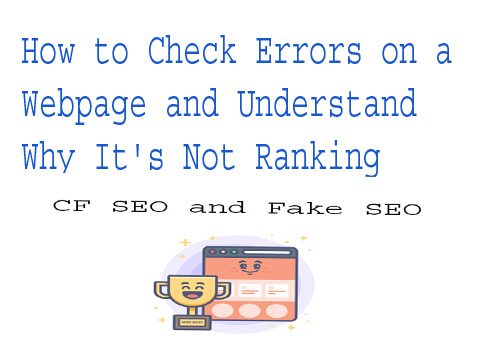If you're wondering why your webpage, like www.aliprice.com/imagetranslation/index.html, is not ranking well on search engines, you're not alone. Many websites face ranking challenges, often due to technical SEO issues, content gaps, or user experience problems. In this article, we'll break down how to diagnose errors on your webpage and provide strategies to help it rank higher.
1. Start with Basic SEO Checks
The first step in identifying why your webpage is not ranking is performing a basic SEO audit. Here are the fundamental aspects to check:a) Check for Broken Links
Broken links, either internal or external, can negatively affect your SEO ranking. Use tools like Screaming Frog or Ahrefs to crawl your webpage and identify any broken links.b) Review Meta Tags
Ensure your page has optimized meta tags, including:- Title Tag: It should include your primary keyword and be under 60 characters.
- Meta Description: This is a brief summary (under 160 characters) of your page that entices clicks.
c) Check for Indexing Issues
Your page may not rank simply because it's not being indexed by Google. Check this by typingsite:www.aliprice.com/imagetranslation/index.html into Google’s search bar. If no results appear, it means the page is not indexed.
To resolve this, ensure that:
- The page is not blocked in your robots.txt file.
- The page does not have a noindex tag.
2. Analyze Page Speed and Mobile-Friendliness
Page load time is a critical factor in rankings. Slow websites drive users away, which leads to higher bounce rates and lower rankings.a) Use PageSpeed Insights
Use Google PageSpeed Insights to evaluate the performance of your webpage. Aim for a score of 90 or higher on both mobile and desktop. Common speed issues to fix:- Optimize Images: Compress large images to reduce load time.
- Minify CSS and JavaScript: Reduce file size and remove unnecessary characters.
- Leverage Browser Caching: Store some elements of your site locally in users’ browsers to speed up loading on repeat visits.
b) Mobile Optimization
More users are browsing from mobile devices than ever before, and Google prioritizes mobile-first indexing. Use Google’s Mobile-Friendly Test to check how your page performs on mobile. If your page isn’t mobile-optimized, consider switching to a responsive design.3. Audit On-Page Content
A well-optimized webpage should have high-quality, relevant content that satisfies user intent. Here’s how you can analyze and improve your content:a) Check Keyword Optimization
Is your page targeting the right keywords? Tools like SEMrush or Ahrefs can help you find keywords that are relevant to your page. Ensure your primary keyword is:- In the title tag
- In the H1 heading
- Sprinkled naturally throughout the content (without keyword stuffing)
b) Content Depth and Quality
Does the content on the page provide value? Thin or low-quality content can cause your webpage to rank poorly. Make sure your content:- Answers user queries
- Provides a solution or valuable information
- Is engaging and well-structured with clear headings (H1, H2, H3)
4. Evaluate User Experience (UX)
Google considers user engagement metrics such as time spent on the page and bounce rate. A poor user experience can negatively affect your ranking.a) Improve Navigation and Design
Ensure your page is easy to navigate. Complicated designs, hard-to-find buttons, and overwhelming ads can turn users away. Use clear call-to-action buttons, simple navigation menus, and a clean design.b) Reduce Pop-ups and Interstitials
Excessive pop-ups and ads can frustrate users and lead to a poor experience. Google penalizes websites with intrusive interstitials, especially on mobile. Make sure that any pop-ups on the page are not disrupting the user’s experience.5. Check for Technical SEO Issues
Technical issues can often be the cause of poor rankings. Here are some common technical SEO aspects to check:a) Review Your Sitemap
Make sure that your sitemap is correctly set up and includes the page you’re trying to rank. Submit your sitemap to Google through Google Search Console.b) Look for Canonicalization Issues
If the content on www.aliprice.com/imagetranslation/index.html is similar to content on other pages of your site, Google may be confused about which version to rank. Set up canonical tags to ensure that Google knows which page to prioritize.c) Structured Data
Using structured data (Schema markup) can help search engines better understand your content. If applicable, add structured data for services, reviews, or other relevant aspects of your page.6. Backlink Profile and Off-Page SEO
Off-page SEO, particularly backlinks, is one of the biggest ranking factors. A weak backlink profile could be the reason why your page isn’t ranking.a) Check Backlinks
Use tools like Ahrefs or Moz to check how many backlinks your page has. If your page has few or low-quality backlinks, consider an outreach campaign to get more.b) Create Shareable Content
The more valuable your content is, the more likely it will be shared and linked to. Create blog posts, videos, or infographics that support your image translation service and encourage users to link back to them.7. Monitor Performance with Google Search Console
Lastly, use Google Search Console regularly to monitor the performance of your webpage. It will provide insights into:- Search queries driving traffic to your page
- Click-through rates (CTR)
- Indexing issues
- Mobile usability problems
